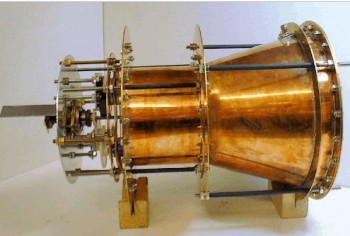Part Two of Two Parts (Please read Part One first)
For a brief period, Shawyer was collaborating with the Boeing company. There were supposed to be contracts for commercial development of the EM engine. Between 2008 and 2010, Shawyer and Boeing built and tested a EM engine which Shawyer claims worked as expected. However, when contacted in 2012, Boeing had dropped the project and simply said that they were no longer working with Shawyer. Shawyer continues to work on the EM design and has filed a series of patents.
Another inventor named Guido Fetta created a similar engine which he named the Cannae drive. Its design had some differences from the EM drive but it is supposed to operate according to the same principles. Fetta created the Cannae company to exploit his invention.
Scientists at a Chinese university built several engines based on cavity resonators and found a slight thrust which later turned out to be a measurement error. A group at NASA's Eagleworks laboratories which was created to test unusual rocket engine designs built and tested versions of both the EM drive and the Cannae drive. They reported a very small amount of thrust which is close to their margin of error.
The bottom line is that three different groups have built and tested these cavity resonator engines and none of them has been able to repeatedly measure significant thrust from their test engines. All their tests had problems with noise and experimental design.
There are a variety of theories about what is happening with the cavity resonator engines. The simplest explanation is that there is no thrust and any measurements that say so are a result of noise and experimental error. Shawyer thinks that the thrust he says that he has measured is a result of unequal radiation pressure between the ends of the cavity. Experts say that his explanation of radiation pressure is not correct. The Eagleworks lab suggested that there may be something they called a "quantum vacuum virtual plasma" acting to create thrust. This idea has been strongly criticized by mathematical physicists who say that vacuum fluctuations do not form plasmas and, even if they did, it would not produce thrust. A scholar at Plymouth University claims that thrust from such engines is the result of quantization of inertia related to a hypothesized phenomena called Unruh radiation. Critics of this idea say that Unruh radiation has never been detected and that quantized inertia would violate special relativity. And, finally, it could be that these engines really are reactionless drives. Such an explanation is very unlikely because a reactionless drive would be a sort of perpetual motion machine. A reactionless drive would violate the conservation of momentum and Newton's Third Law of Motion. Such a drive would have to be based on a new undiscovered physical law.
In any case, Guido Fetta, inventor of the Cannae drive has announced that he will launch one of his drives into space aboard a CubeSat sometime in 2017. The drive will be tested in space for six months. NASA Eagleworks has tested their drive in a hard vacuum and registered a slight amount of thrust. They will soon publish their results in a peer-reviewed journal. Regardless of whether or not a reasonable theory of operation exists for these cavity resonator engines, if someone can actually test one in space and demonstrate that it works, it will mean radical changes for space propulsion.
EM Drive:
